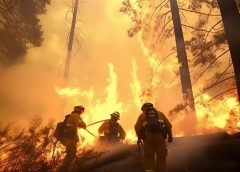The design of firefighting PPE is purposeful, with safety and protection at the core. Whether they’re helping firefighters control structural or wildland fires, the gear must handle intense heat, flames, smoke, and other hazards.
Though both types of firefighters require protection from many of the same dangers, their gear differs. Read on as we discuss wildland fire gear versus structural bunker gear.
How Wildland and Structural Fire Fighting Differ
All firefighting jobs are dangerous and require training, strength, stamina, and commitment. However, a structural firefighter and a wildland firefighter have different responsibilities and work under varying conditions.
Different Seasons
Structural fires can happen any time of the year, so structural firefighters are on call all year long. Wildland firefighters, however, have a firefighting season, usually the summer and fall (about four to six months).
Different Battles
Structural firefighters serve the public by responding to the following emergencies:
- Fire alarms
- Residential homes, commercial buildings, and other structural fires
- Chemical spills clean up
- Medical emergencies
Wildland firefighters’ duties include the following:
- Creating protective lines to prevent fires from spreading.
- Parachuting from planes to fight fires.
- Removing trees.
- Using geospatial devices and maps to determine how to put out flames.
- Rescuing hikers.
- Burning natural areas that may fuel forest fires.
The Weight of Firefighting Gear
One of the biggest differences between wildland and structural fire gear is the weight of what they carry and wear. Wildland firefighters encounter many unique situations that require them to hike, jump from planes, and move around obstacles. For these reasons, they cannot carry as much heavy equipment or wear as much gear as structural firefighters. Let’s look at some ways their load differs in weight.
Firefighting Boots
Wildland firefighters need comfortable boots since they’re so active. The history of wildland firefighting boots shows us how the design has improved through the years to bring these brave people lightweight, comfortable boots with excellent traction. Modern wildland firefighting boots help them move through rocky, wooded, and dangerous terrain.
Structural firefighters wear bunker boots made of rubber or leather with a steel toe. They are ideal for heat resistance and foot protection should anything fall on a firefighter’s foot. Bunker boots don’t have the same sole or arch as wildland firefighting boots since structural firefighters aren’t covering long distances on calls.
Here are some more comparisons of the PPE each type of firefighter carries:
Wildland
- GPS
- Fire shelter
- Line gear
- First aid kit
- Chainsaw
- Radio
- Drip torches
Structural
- Radio
- Ax
- SCBA
A structural firefighter carries about 70 pounds of gear! In comparison, wildland firefighters carry around 25–40 pounds of equipment so that they can move more freely for longer. All communities are grateful for both types of fire protection, and we thank those who bravely serve.


